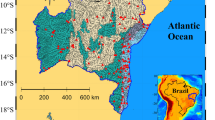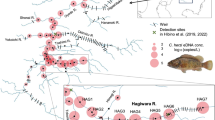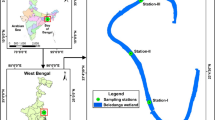Abstract
Biomonitoring of least disturbed areas is a crucial issue to accurately assess the ecological status of surface waters and ensure their sustainability. Diatom metrics are important tools for the assessment of environmental conditions of lotic ecosystems to achieve environmental sustainability. The present study was aimed to evaluate the ecological status of least disturbed areas in the Antalya River basin (Turkey) using diatom indices developed from different ecoregion. Diatom species such as Cymbella excisa, Achnanthidium minutissimum, Cocconeis euglypta, and Cocconeis placentula were the most contributing species to the dissimilarity of sampling stations between rainy and dry seasons. The first two axes of canonical correspondence analysis (CCA) elucidated a strong (86%) correlation between diatom taxa and stressors. Results of the Monte Carlo permutation test indicated that total phosphorus (TP), water temperature, Tin (Sn), total organic carbon, zinc, and pH are significantly influential ecological factors on the distribution of diatom taxa among sampling stations. The Spearman correlation rank test indicated that diatom indices had significant positive and negative correlations with TP gradient. Results revealed that diatom indices developed from different ecoregions have different scores for the eco-assessment of similar sampling stations. European diatom indices mostly showed similar behavior in the bioassessment of the ecological status of rivers in the Antalya region compared to the different ecoregion. Among European diatom indices, TIT was more competitive and could give better results in the bio-evaluation of rivers in the Antalya River basin. Using diatom indices developed from different ecoregions may lead to an erroneous assessment of water quality. Accordingly, ecoregional specific diatom metrics are needed to accurately determine the surface water quality.
Graphical abstract

Eco-assessment of least disturbed areas of the Antalya River basin: application of diatom indices from different ecoregions: Abuzer Çelekli, Ömer Lekesiz, Tolga Çetin



Similar content being viewed by others
Data availability
Not applicable.
References
Álvarez-Blanco I, Blanco S, Cejudo-Figueiras C, Bécares E (2013) The Duero Diatom Index (DDI) for river water quality assessment in NW Spain: Design and validation. Environ Monit Assess 185(1):969–981
APHA (2012) American Public Health Association. American Water Works Association, Water Environment Federation, Standard Methods for the Examination of Water and Wastewater. 22nd Edition, p1496
Bey M, Ector L (2013) Atlas des diatomées des cours d’eau de la région Rhône-Alpes. Tome 1 Centriques, Monoraphidées. Tome 2 Araphidées, Brachyraphidées. Tome 3 Naviculacées: Naviculoidées. Tome 4 Naviculacées: Naviculoidées. Tome 5 Naviculacées: Cymbelloidées, Gomphonématoidées. Tome 6 Bacillariacées, Rhopalodiacées, Surirellacées, pp1–1182
Birk S, Bonne W, Borja A, Brucet S, Courrat A, Poikane S, Solimini A, van de Bund W, Zampoukas N, Hering D (2012) Three hundred ways to assess Europe’s surface waters: an almost complete overview of biological methods to implement the Water Framework Directive. Ecol Indic 18:31–41
Borja A, Barbone E, Basset A, Borgersen G, Brkljacic M, Elliott M, Garmendia JM, Marques JC, Mazik K, Muxika I (2011) Response of single benthic metrics and multi-metric methods to anthropogenic pressure gradients, in five distinct European coastal and transitional ecosystems. Mar Pollut Bull 62(3):499–513
Cantonati M, Angeli N, Bertuzzi E, Spitale D, Lange-Bertalot H (2012) Diatoms in springs of the Alps: spring types, environmental determinants, and substratum. Freshw Sci 31(2):499–524
Çelekli A, Bilgi F (2019) Bioassessing ecological status of surface waters in the Araban-Yavuzeli catchment (Turkey): application of diatom indices. Turk J Bot 43:597–607
Çelekli A, Kapı E (2019) Ecoregion approach in the assessment of aquatic ecosystems in the west of Gaziantep (Turkey): application of diatom metrics. Ecol Indic 103:373–382
Çelekli A, Lekesiz Ö (2020) Eco-assessment of West Mediterranean basin’s rivers (Turkey) using diatom metrics and multivariate approaches. Environ Sci Pollut Res 27(22):27796–27806
Çelekli A, Şahin G (2021) Bio-assessment of wastewater effluent conditions with algal pollution index and multivariate approach. J Clean Prod 310
Çelekli A, Toudjani AA, Lekesiz HÖ, Çetin T (2018) Ecological quality assessment of running waters in the North Aegean catchment with diatom metrics and multivariate approach. Limnologica 73:20–27
Çelekli A, Toudjani AA, Gümüş EY, Kayhan S, Lekesiz HÖ, Çetin T (2019) Determination of trophic weight and indicator values of diatoms in Turkish running waters for water quality assessment. Turk J Bot 43(1):90–101
Cemagref (1982) Etude des méthodes biologiques d’ appréciation quantitative de la qualité des eaux. - Rapport Q. Ee. Lyon. - A. F. Bassin RhôneMéditerranée-Corse. pp 218
Charles DF, Kelly MG, Stevenson RJ, Poikane S, Theroux S, Zgrundo A, Cantonati M (2021) Benthic algae assessments in the EU and the US: Striving for consistency in the face of great ecological diversity. Ecol Indic 121:107082
Chen X, Zhou W, Luo G, Luo P, Chen Z (2020) Spatial and temporal variations of the diatom communities in megacity streams and its implications for biological monitoring. Environ Sci Pollut Res 27(30):37581–37591
Chessman BC, Bate N, Gell PA, Newall P (2007) A diatom species index for bioassessment of Australian rivers. Mar Freshw Res 58(6):542
Cho I-H, Kim H-K, Lee M-H, Kim Y-J, Lee H, Kim B-H (2020) The effect of monsoon rainfall patterns on epilithic diatom communities in the Hantangang River, Korea. Water 12(5):1471
Çiner A, Karabiyikoğlu M, Monod O (2008) Late Cenozoic sedimentary evolution of the Antalya Basin, southern Turkey. Turk J Earth Sci 17(1):1–41
Das T, Pal AK, Chakraborty SK, Manush SM, Dalvi RS, Sarma K, Mukherjee SC (2006) Thermal dependence of embryonic development and hatching rate in Labeo rohita (Hamilton, 1822). Aquaculture. 255:536–541. https://doi.org/10.1016/j.aquaculture.2006.01.013
Delgado C, Pardo I (2015) Comparison of benthic diatoms from Mediterranean and Atlantic Spanish streams: community changes in relation to environmental factors. Aquat Bot 120(PB):304–314
Delgado C, Pardo I, García L (2010) A multimetric diatom index to assess the ecological status of coastal Galician rivers (NW Spain). Hydrobiologia 644(1):371–384
Delgado C, Pardo I, García L (2012) Diatom communities as indicators of ecological status in Mediterranean temporary streams (Balearic Islands, Spain). Ecol Indic 15(1):131–139
Dell’Uomo A (2004) L’indice diatomico di eutrofizzazione/polluzione (EPI-D) nel monitoraggio delle azque correnti, line guida. Dipartimento di Botanica ed Ecologia, Universita di Camerino
Della Bella V, Pace G, Barile M, Zedde A, Puccinelli C, Ciadamidaro S, Danieli PP, Andreani P, Aulicino FA, Belfiore C (2012) Benthic diatom assemblages and their response to human stress in small-sized volcanic-siliceous streams of central Italy (Mediterranean eco-region). Hydrobiologia 695(1):207–222
Directive (2000) Directive 2000/60/EC of the European Parliament and of the Council establishing a framework for Community action in the field of water policy. OJ L327, 22.12.2000. https://doi.org/10.3000/17252555.L_2009.140.eng
EC (2009) European Committee for Standardization, Water Framework Directive intercalibration technical report. Part 2. In: Poikane S (ed) Lakes. European Commission, Joint Research Centre, Ispra (Italy)
Espinosa MA, Vélez-Agudelo C, Isla FI (2020) Diatom responses to natural and anthropogenic environmental changes in a Patagonian river, Argentina. J S Am Earth Sci 102:102677
European Committee for Standardization (2014) European Committee for Standardization. In: Water quality-guidancefor the routine sampling and preparation of benthic diatoms fromrivers and lakes, vol 13946. European Standard EN, Brussels, p 17
Falasco E, Bona F (2011) Diatom community biodiversity in an Alpine protected area: a study in the Maritime Alps Natural Park. J Limnol 70(2):157
Feio MJ, Aguiar FC, Almeida SFP, Ferreira MT (2012) AQUAFLORA: a predictive model based on diatoms and macrophytes for streams water quality assessment. Ecol Indic 18:586–598
Feio MJ, Aguiar FC, Almeida SFP, Ferreira J, Ferreira MT, Elias C, Serra SRQ, Buffagni A, Cambra J, Chauvin C, Delmas F, Dörflinger G, Erba S, Flor N, Ferréol M, Germ M, Mancini L, Manolaki P, Marcheggiani S, Minciardi MR, Munné A, Papastergiadou E, Prat N, Puccinelli C, Rosebery J, Sabater S, Ciadamidaro S, Tornés E, Tziortzis I, Urbanič G, Vieira C (2014) Least disturbed condition for European Mediterranean rivers. Sci Total Environ 476–477:745–756
Feio MJ, Filipe AF, Garcia-Raventos A, Ardura Gutiérrez A, Calapez AR, Pujante AM, Mortagua A, Múrria C, Díaz de Quijano D, Martins F (2020) Advances in the use of molecular tools in ecological and biodiversity assessment of aquatic ecosystems. Asoc Ibérica Limnol 39(1):419–440
Freitas NCW, Heinrich CG, Etges T, de Souza CG, Lobo EA (2021) Assessment of potential reference sites for evaluating the ecological status of subtropical and temperate Brazilian lotic systems using the epilithic diatom community. Environ Sci Pollut Res 28(7):8698–8708
Gomà J, Rimet F, Cambra J, Hoffmann L, Ector L (2005) Diatom communities and water quality assessment in mountain rivers of the Upper Segre Basin (La Cerdanya, Oriental Pyrenees). Hydrobiologia 551(1):209–225
Gómez N, Licursi M (2001) The Pampean Diatom Index (IDP) for assessment of rivers and streams in Argentina. Aquat Ecol 35(2):173–181
Hering D, Borja A, Carstensen J, Carvalho L, Elliott M, Feld CK, Heiskanen A-S, Johnson RK, Moe J, Pont D (2010) The European Water Framework Directive at the age of 10: a critical review of the achievements with recommendations for the future. Sci Total Environ 408(19):4007–4019
Holmes M, Taylor J (2015) Diatoms as water quality indicators in the upper reaches of the Great Fish River, Eastern Cape, South Africa. Afr J Aquat Sci 40(4):321–337
Juggins S, ter Braak C (1992) Calibrate-Program for species-environment calibration by (weighted averaging) partial least squares regression. Environmental Change Res Cent University College London
Kelly M, Juggins S, Guthrie R, Pritchard S, Jamieson J, Rippey B, Hirst H, Yallop M (2008) Assessment of ecological status in UK rivers using diatoms. Freshw Biol 53(2):403–422
Kelly M, Urbanic G, Acs E, Bennion H, Bertrin V, Burgess A, Denys L, Gottschalk S, Kahlert M, Karjalainen SM, Kennedy B, Kosi G, Marchetto A, Morin S, Picinska-Fałtynowicz J, Poikane S, Rosebery J, Schoenfelder I, Schoenfelder J, Varbiro G (2014) Comparing aspirations: intercalibration of ecological status concepts across European lakes for littoral diatoms. Hydrobiologia 734(1):125–141
Kolkwitz R, Marson M (1908) Ökologie der pflanzlichen Saprobien. Berichte der Deutschen Botanischen Gesellschaft. Ber Dtsch Bot Ges 26:505–519
Krammer K (2000) Diatoms of Europe. In: Lange-Bertalot H (ed) The Genus Pinnularia, Vol. 1–703, vol 1. A. R. G. Gantner Verlag K. G, Ruggel, pp 1–703
Krammer K (2002) Diatoms of the European Inland Waters and Comparable Habitats, Cymbella, vol 3. Gantner Verlag, Ruggell
Lai GG, Padedda BM, Ector L, Wetzel CE, Lugliè A, Cantonati M (2020) Mediterranean karst springs: diatom biodiversity hotspots under the pressure of hydrological fluctuation and nutrient enrichment. Plant Biosyst - Int J Deal Asp Plant Biol 154(5):673–684
Lange-Bertalot H (2001) Navicula sensu stricto and 10 genera separated from Navicula sensu lato, Frus-tulia. – Diatoms of Europe 2. Gantner Verlag, Ruggell, pp 1–526
Lange-Bertalot H, Hofmann G, Werum M, Cantonati M, Kelly MG (2017) In: Kelly MG (ed) Freshwater benthic diatoms of Central Europe: over 800 common species used in ecological assessment, vol 942. Koeltz Botanical Books, Schmitten-Oberreifenberg
Lavoie I, Hamilton PB, Wang YK, Dillon PJ, Campeau S (2009) A comparison of stream bioassessment in Québec (Canada) using six European and North American diatom-based indices. Nova Hedwig Beih 135:37–56
Lazaridou M, Ntislidou C, Karaouzas I, Skoulikidis N (2018) Harmonisation of a new assessment method for estimating the ecological quality status of Greek running waters. Ecol Indic 84:683–694
Lobo EA, Schuch M, Heinrich CG, da Costa AB, Düpont A, Wetzel CE, Ector L (2015) Development of the Trophic Water Quality Index (TWQI) for subtropical temperate Brazilian lotic systems. Environ Monit Assess 187(6):354
Lobo EA, Heinrich CG, Schuch M, Wetzel CE, Ector L (2016) Diatoms as bioindicators in rivers. In: River Algae. Springer International Publishing, Cham, pp 245–271
Merga L, Mengistie A, Faber J, Van den Brink P (2020) Trends in chemical pollution and ecological status of Lake Ziway, Ethiopia: a review focussing on nutrients, metals and pesticides. Afr J Aquat Sci 45(4):386–400
Oeding S, Taffs KH (2017) Develo** a regional diatom index for assessment and monitoring of freshwater streams in sub-tropical Australia. Ecol Indic 80:135–146
Omernik JM (1987) Ecoregions of the conterminous United States. Ann Assoc Am Geogr 77(1):118–125
Potapova M, Charles DF (2007) Diatom metrics for monitoring eutrophication in rivers of the United States. Ecol Indic 7(1):48–70
Potapova MG, Charles DF, Ponader KC, Winter DM (2004) Quantifying species indicator values for trophic diatom indices: a comparison of approaches. Hydrobiologia 517(1–3):25–41
Rimet F, Ector L, Cauchie HM, Hoffmann L (2004) Regional distribution of diatom assemblages in the headwater streams of Luxembourg. Hydrobiologia 520(1–3):105–117
Rott E, Pipp E, Pfister P, van Dam H, Ortler K, Binder N, Pall K (1999) Indikationslisten für Aufwuchsalgen in österreichischen Fließgewässer Trophieindikation (sowie geochemische Präferenzen, taxonomische und toxikologische Anmerkungen). Wasserwirtschaftskataster. Bundesministerium für Land-und Forstwirtschaft, Wasserwirtschaftskataster, Wien. p 248
Salinas-Camarillo VH, Carmona-Jiménez J, Lobo EA (2021) Development of the Diatom Ecological Quality Index (DEQI) for peri-urban mountain streams in the Basin of Mexico. Environ Sci Pollut Res 28(12):14555–14575
Seaby RM, Henderson PA (2007) Community Analyses Package (CAP 4.1. 3.). Engl Pisces Conserv Ltd
Stenger-Kovács C, Buczkó K, Hajnal É, Padisák J (2007) Epiphytic, littoral diatoms as bioindicators of shallow lake trophic status: Trophic Diatom Index for Lakes (TDIL) developed in Hungary. Hydrobiologia 589(1):141–154
Szczepocka E, Szulc B (2009) The use of benthic diatoms in estimating water quality of variously polluted rivers. Oceanol Hydrobiol Stud 38(1):17–26
ter Braak CJF, Šmilauer P (2002) CANOCO Reference Manual and CanoDraw for Windows User's Guide: Software for Canonical Community Ordination (version 4.5). http://www.canoco.com
Wang X, Zheng B, Liu L, Li L (2014) Use of Diatoms in river health assessment. Annu Res Rev Biol 4(24):4054–4074
Winter JG, Duthie HC (2000) Epilithic diatoms as indicators of stream total N and total P concentration. J North Am Benthol Soc 19(1):32–49
Acknowledgements
We thank Dr. Mehmet Yavuzatmaca for his help.
Funding
This study was supported by T.R. Ministry of Agriculture and Forestry, General Directorate of Water Management, Çınar Engineering Co., and the Scientific Research Projects Executive Council of Gaziantep University, which supported this research.
Author information
Authors and Affiliations
Contributions
AÇ applied the sampling methodology, collected samples, analyzed physico-chemical variables, identified diatom species, applied statistical analyses, written, reviewed, and edited the article. ÖL collected samples, analyzed physico-chemical variables, identified diatom species, and drawn the map of the studied region. TÇ applied the sampling methodology. All authors read and approved the final manuscript.
Corresponding author
Ethics declarations
Ethics approval and consent to participate
Not applicable.
Consent for publication
Not applicable.
Competing interests
The authors declare no competing interests.
Additional information
Responsible Editor: Thomas Hein
Publisher’s note
Springer Nature remains neutral with regard to jurisdictional claims in published maps and institutional affiliations.
Supplementary Information
ESM 1
(DOCX 22 kb)
Rights and permissions
About this article
Cite this article
Çelekli, ., Lekesiz, Ö. & Çetin, T. Eco-assessment of least disturbed areas of the Antalya River basin: application of diatom indices from different ecoregions. Environ Sci Pollut Res 29, 790–804 (2022). https://doi.org/10.1007/s11356-021-15394-0
Received:
Accepted:
Published:
Issue Date:
DOI: https://doi.org/10.1007/s11356-021-15394-0




